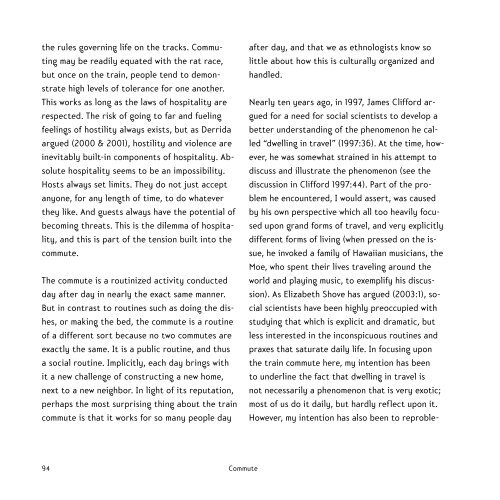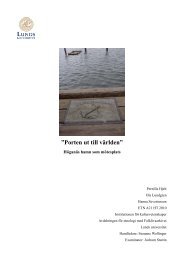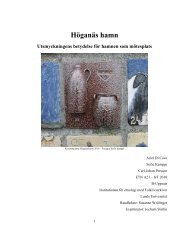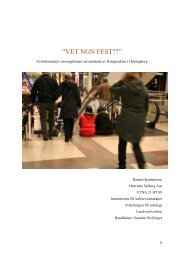Extern fulltext (Nytt fönster) - Institutionen för konst- och ...
Extern fulltext (Nytt fönster) - Institutionen för konst- och ...
Extern fulltext (Nytt fönster) - Institutionen för konst- och ...
You also want an ePaper? Increase the reach of your titles
YUMPU automatically turns print PDFs into web optimized ePapers that Google loves.
the rules governing life on the tracks. Commuting<br />
may be readily equated with the rat race,<br />
but once on the train, people tend to demonstrate<br />
high levels of tolerance for one another.<br />
This works as long as the laws of hospitality are<br />
respected. The risk of going to far and fueling<br />
feelings of hostility always exists, but as Derrida<br />
argued (2000 & 2001), hostility and violence are<br />
inevitably built-in components of hospitality. Absolute<br />
hospitality seems to be an impossibility.<br />
Hosts always set limits. They do not just accept<br />
anyone, for any length of time, to do whatever<br />
they like. And guests always have the potential of<br />
becoming threats. This is the dilemma of hospitality,<br />
and this is part of the tension built into the<br />
commute.<br />
The commute is a routinized activity conducted<br />
day after day in nearly the exact same manner.<br />
But in contrast to routines such as doing the dishes,<br />
or making the bed, the commute is a routine<br />
of a different sort because no two commutes are<br />
exactly the same. It is a public routine, and thus<br />
a social routine. Implicitly, each day brings with<br />
it a new challenge of constructing a new home,<br />
next to a new neighbor. In light of its reputation,<br />
perhaps the most surprising thing about the train<br />
commute is that it works for so many people day<br />
94 Commute<br />
after day, and that we as ethnologists know so<br />
little about how this is culturally organized and<br />
handled.<br />
Nearly ten years ago, in 1997, James Clifford argued<br />
for a need for social scientists to develop a<br />
better understanding of the phenomenon he called<br />
“dwelling in travel” (1997:36). At the time, however,<br />
he was somewhat strained in his attempt to<br />
discuss and illustrate the phenomenon (see the<br />
discussion in Clifford 1997:44). Part of the problem<br />
he encountered, I would assert, was caused<br />
by his own perspective which all too heavily focused<br />
upon grand forms of travel, and very explicitly<br />
different forms of living (when pressed on the issue,<br />
he invoked a family of Hawaiian musicians, the<br />
Moe, who spent their lives traveling around the<br />
world and playing music, to exemplify his discussion).<br />
As Elizabeth Shove has argued (2003:1), social<br />
scientists have been highly preoccupied with<br />
studying that which is explicit and dramatic, but<br />
less interested in the inconspicuous routines and<br />
praxes that saturate daily life. In focusing upon<br />
the train commute here, my intention has been<br />
to underline the fact that dwelling in travel is<br />
not necessarily a phenomenon that is very exotic;<br />
most of us do it daily, but hardly reflect upon it.<br />
However, my intention has also been to reproble-









